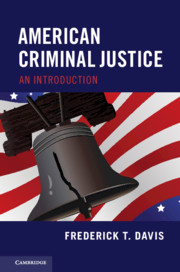Book contents
- American Criminal Justice
- American Criminal Justice
- Copyright page
- Dedication
- Contents
- Acknowledgments
- 1 Introduction
- 2 The Federal Structure; Sources of the Law
- 3 Investigation and Evidence-Gathering—The Participants
- 4 Investigation and Evidence-Gathering—Procedures
- 5 Arrest and Pretrial Detention
- 6 The Decision to Prosecute, or Not
- 7 Joinder of Charges and Defendants
- 8 Venue
- 9 Assistance of Counsel
- 10 Trial Rights and Preparation for Trial
- 11 Alternative Outcomes
- 12 Double Jeopardy
- 13 The Trial
- 14 Sentencing
- 15 Appeals
- 16 Corporate Criminal Responsibility
- 17 Internal Corporate Investigations
- 18 Professional Responsibility
- 19 Conclusion
- Bibliography
- Index
3 - Investigation and Evidence-Gathering—The Participants
Published online by Cambridge University Press: 08 June 2019
- American Criminal Justice
- American Criminal Justice
- Copyright page
- Dedication
- Contents
- Acknowledgments
- 1 Introduction
- 2 The Federal Structure; Sources of the Law
- 3 Investigation and Evidence-Gathering—The Participants
- 4 Investigation and Evidence-Gathering—Procedures
- 5 Arrest and Pretrial Detention
- 6 The Decision to Prosecute, or Not
- 7 Joinder of Charges and Defendants
- 8 Venue
- 9 Assistance of Counsel
- 10 Trial Rights and Preparation for Trial
- 11 Alternative Outcomes
- 12 Double Jeopardy
- 13 The Trial
- 14 Sentencing
- 15 Appeals
- 16 Corporate Criminal Responsibility
- 17 Internal Corporate Investigations
- 18 Professional Responsibility
- 19 Conclusion
- Bibliography
- Index
Summary
Most criminal investigations are initiated by police, either acting reactively in immediate response to a situation (in flagrante) or proactively in the absence of an immediate need for police intervention. At the federal level, there are several specialized police agencies, including the Federal Bureau of Investigation (FBI), the Drug Enforcement Agency, the Secret Service (which is tasked with protecting the President but also with investigating counterfeiting), and the Bureau of Alcohol, Tobacco, Firearms, and Explosives. Most investigative federal agencies report directly or indirectly to the Attorney General of the United States, who heads the Department of Justice. Each state organizes its own police functions as it sees fit. Counties, cities, or small towns within a state may have police forces that may range in scale from the New York City Police Department, composed of approximately twenty thousand officers, to a village that may have one policeman. While some state law enforcement officials are locally elected, federal officers are not. Although they investigate and enforce different bodies of laws (see Chapter 2.A.1), federal and state police authorities generally coordinate harmoniously, either informally or through so-called joint task forces.
- Type
- Chapter
- Information
- American Criminal JusticeAn Introduction, pp. 19 - 24Publisher: Cambridge University PressPrint publication year: 2019



